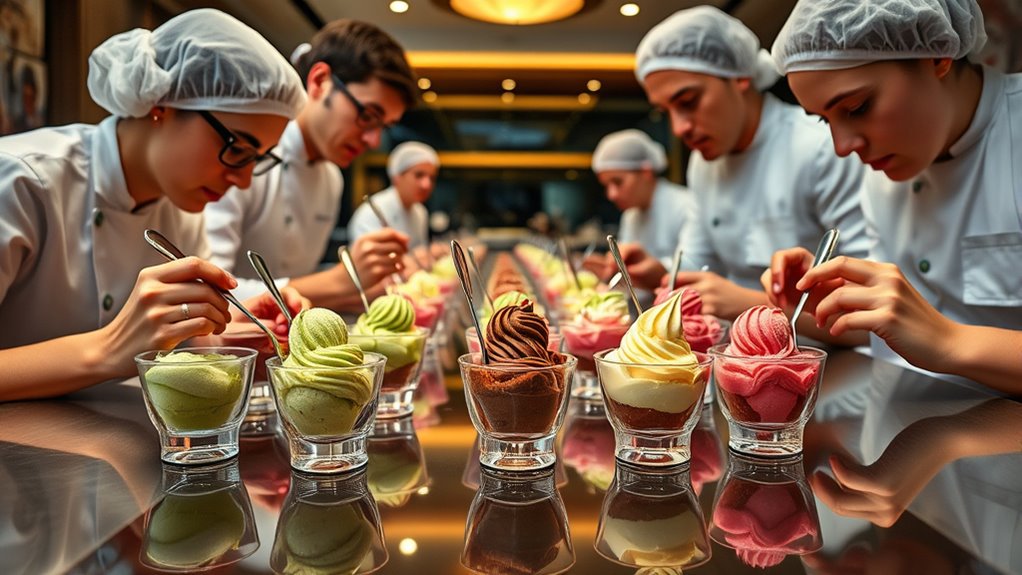When you step into a professional gelato tasting session, you’ll find a dedicated panel carefully evaluating each flavor’s taste, aroma, and texture. You’ll compare samples side-by-side, paying close attention to flavor balance, color, and consistency. Palate cleansing is used to ascertain clear impressions, and team feedback helps fine-tune every recipe. If you keep exploring, you’ll discover how this detailed process elevates every scoop to perfection.
Key Takeaways
- The panel evaluates gelato based on taste, texture, aroma, and visual appearance to ensure quality and flavor consistency.
- They use systematic tasting techniques, including palate cleansing, to accurately assess flavor development and balance.
- Multiple samples are compared side-by-side, with detailed notes guiding recipe adjustments and improvements.
- Aromatic and visual cues are analyzed to support flavor perception and overall appeal.
- Feedback from the panel influences flavor profile refinement and maintains high product standards.

Imagine savoring a variety of gelato flavors as a dedicated panel carefully evaluates each one for taste, texture, and aroma. You’re part of this process, where every scoop is scrutinized to guarantee it hits the perfect notes. Achieving a harmonious gelato experience relies heavily on understanding gelato flavor balance. You look for a well-rounded profile where sweetness, acidity, and intensity blend seamlessly, avoiding overpowering or underwhelming sensations. The goal is to create a flavor that excites the palate without overwhelming it, striking a delicate equilibrium that highlights each ingredient’s role. To do this effectively, tasting panel techniques come into play, guiding you through a systematic evaluation process.
First, you observe the gelato’s appearance, noting its color and consistency, which often hint at its flavor profile. Then, you proceed to aroma assessment, taking a gentle sniff to detect initial impressions. The aroma can reveal subtle hints of fruit, nuts, or spices that influence the overall perception. As you take your first bite, you focus on the texture—smooth, creamy, or sometimes slightly grainy—and how it complements the flavor. Texture influences how flavors are released and perceived, making it an essential part of your evaluation.
Observe the gelato’s appearance and aroma to gain clues about its flavor profile.
Next, you pay close attention to the taste itself. This involves evaluating the gelato’s flavor intensity and balance. Is the sweetness just right, not overpowering? Do the flavors develop gradually, revealing complexity, or are they immediate and straightforward? You might notice if a flavor feels muted or overly dominant, which indicates a need for adjustment. Using tasting panel techniques, you often compare samples side-by-side to identify subtle differences and guarantee consistency. This comparison helps in fine-tuning recipes, maintaining quality, and delivering a product that delights consumers.
Throughout the session, you’re trained to cleanse your palate between tastings—usually with water or plain bread—to reset your senses and avoid flavor carryover. This step is vital for accurate judgment. You also take notes, recording your impressions of each flavor, texture, and aroma, which later contribute to a detailed evaluation report. The process is collaborative; feedback from the panel influences decisions about ingredient proportions, flavor enhancements, and overall presentation. Additionally, understanding color accuracy can help in assessing visual appeal, which plays a role in overall flavor perception.
Frequently Asked Questions
How Are Panelists Selected for Gelato Tastings?
You’re selected for gelato tastings based on your palate, experience, and knowledge of gelato history and flavor pairing. Panelists often have a background in culinary arts or food science, ensuring they can identify subtle nuances. Your ability to suggest innovative flavor combinations and understand traditional gelato techniques helps the team. This process guarantees a diverse, skilled panel that appreciates the art and science behind crafting perfect gelato flavors.
What Criteria Do Panelists Use to Evaluate Gelato?
When evaluating gelato, you focus on flavor balance and texture consistency. You assess whether the flavors are harmonious and not overpowering, and whether the texture is smooth, creamy, and evenly frozen. You also consider the overall aroma and mouthfeel, ensuring each element complements the others. Your goal is to identify the gelato’s quality and craftsmanship by paying close attention to these critical criteria during tasting.
How Many Flavors Are Typically Sampled During a Session?
Imagine you’re on a flavor safari, exploring diverse taste landscapes. During a session, you typically sample around 8 to 12 flavor combinations, allowing you to fully engage your tasting techniques. This range helps you appreciate each gelato’s unique qualities without overwhelming your palate. By focusing on a manageable number, you can truly evaluate textures, aromas, and flavors, ensuring each tasting is a memorable journey through the vibrant world of gelato.
Do Panelists Discuss Their Opinions During the Tasting?
During a tasting, you’ll usually see panelists openly discuss their opinions, focusing on flavor harmony and texture analysis. This interaction helps identify which flavors complement each other and how the gelato feels on the palate. Your input is essential, as shared insights lead to a better understanding of the product’s quality. So, yes, panelists actively discuss their impressions, ensuring a thorough and collaborative evaluation of each flavor.
How Is Bias Minimized in a Professional Tasting Panel?
To minimize bias in a professional tasting panel, you’re often encouraged to participate in blind tasting, where you don’t know the brand or ingredients. This helps guarantee your scoring is based solely on flavor and quality, promoting scoring consistency across panelists. By focusing on objective evaluation and avoiding external influences, you can provide more accurate, impartial assessments, which ultimately leads to a more reliable overall judgment of the gelato.
Conclusion
Now that you’ve seen how a professional gelato tasting unfolds, it’s clear that every scoop is a journey of flavor and craftsmanship. Did you know that only 10% of tasters can identify all the subtle notes in a complex gelato? Next time you indulge, take a moment to savor each bite, appreciating the skill behind it. Your next tasting could be more insightful—and delicious—than ever before.









